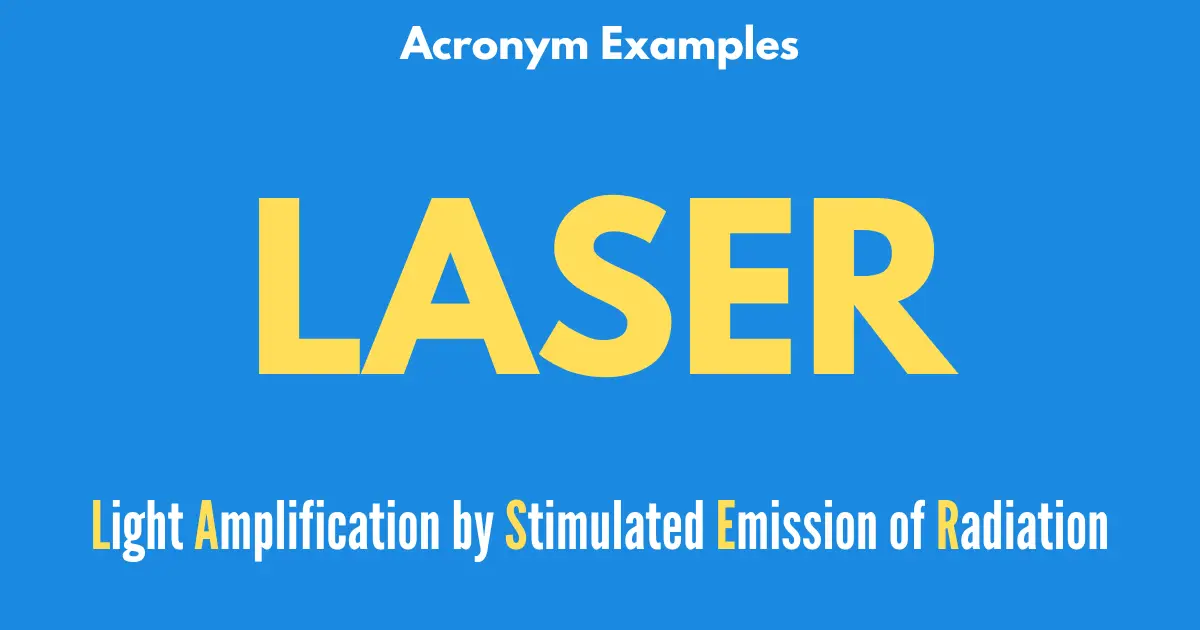Understanding Acronyms: 50 Common Examples Found in Everyday English
There are many examples of acronyms in English, and some may surprise you! Did you know, for example, that the word “Laser” is actually an acronym for Light Amplification by Stimulated Emission of Radiation? I certainly didn’t until I did research for this post!
Acronyms are a type of abbreviation formed from the initial letters of other words and pronounced as a word. A well-known example of an acronym is “NASA” which stands for National Aeronautics and Space Administration.
Learning common acronyms is important for English language learners because they appear so frequently in everyday language and are used in various fields and industries. Below you’ll find an extensive list of common acronyms that are frequently used in English, and a printable list to help you teach or learn these abbreviated words.
What Is An Acronym?
An acronym is a type of abbreviation formed from the initial letters of a series of words, creating a new word that is spoken as it’s written. These linguistic shortcuts are used for efficiency and often become words we regularly use without thinking about their longer meanings. Some common examples of acronyms are:
- NASA: National Aeronautics and Space Administration
- SIM: Subscriber Identity Module
- SCUBA: Self-Contained Underwater Breathing Apparatus
Abbreviations vs Acronyms vs Initialism
Abbreviations are a broad category encompassing any shortened form of a word or phrase. This includes not only acronyms and initialisms but also other methods of shortening words. They can be contractions like “can’t” for “cannot,” truncations like “app” for “application,” or the use of symbols like “&” for “and.” Abbreviations are used to save space and time in writing and speaking.
However, acronyms and initialisms are specific types of abbreviations that are often confused. They both are made from the first letters of a series of words, but they differ in pronunciation and sometimes in usage.
Acronyms are said as words themselves. For instance, “NASA” is pronounced as “na-sa,” and “SCUBA” is pronounced as “skoo-ba.” They transform the series of words into a new, pronounceable term. Acronyms are often used when the series of words is frequently referenced, making them easier to say and remember.
Initialisms, on the other hand, are spoken as the individual letters representing the words. Consider “FBI,” which stands for Federal Bureau of Investigation. It’s pronounced as “F-B-I,” with each letter said individually. Similarly, “ATM” stands for Automated Teller Machine and is pronounced as “A-T-M.” Initialisms are typically used when the series of words is less frequently spoken or when each word’s emphasis is necessary.
Acronym Examples
- ASAP – As Soon As Possible
- NASA – National Aeronautics and Space Administration
- SCUBA – Self-Contained Underwater Breathing Apparatus
- LASER – Light Amplification by Stimulated Emission of Radiation
- NATO – North Atlantic Treaty Organization
- AIDS – Acquired Immune Deficiency Syndrome
- SIM – Subscriber Identity Module
- RAM – Random Access Memory
- OSHA – Occupational Safety and Health Administration
- SWAT – Special Weapons And Tactics
- UNESCO – United Nations Educational, Scientific and Cultural Organization
- UNICEF – United Nations International Children’s Emergency Fund
- AWOL – Absent Without Leave
- SONAR – Sound Navigation And Ranging
- TASER – Thomas A. Swift’s Electric Rifle
- ZIP – Zone Improvement Plan
- SARS – Severe Acute Respiratory Syndrome
- POTUS – President Of The United States
- GIF – Graphics Interchange Format
- JPEG – Joint Photographic Experts Group
- NIMBY – Not In My BackYard
- AMBER – America’s Missing: Broadcast Emergency Response
- OPEC – Organization of the Petroleum Exporting Countries
- PETA – People for the Ethical Treatment of Animals
- SAARC – South Asian Association for Regional Cooperation
- SIDS – Sudden Infant Death Syndrome
- STEM – Science, Technology, Engineering, and Mathematics
- WYSIWYG – What You See Is What You Get
- BASIC – Beginner’s All-purpose Symbolic Instruction Code
- DINK – Dual Income, No Kids
- HUD – Housing and Urban Development
- NEST – Nuclear Emergency Support Team
- QUANGO – Quasi-Autonomous Non-Governmental Organization
- TIARA – Tactical Intelligence And Related Activities
- VISTA – Volunteers in Service to America
- WAIS – Wechsler Adult Intelligence Scale
- PACER – Public Access to Court Electronic Records
- MIRV – Multiple Independently targetable Reentry Vehicle
- JATO – Jet-Assisted Take Off
- ICBM – Intercontinental Ballistic Missile
- HEPA – High-Efficiency Particulate Air
- EMT – Emergency Medical Technician
- COMSAT – Communications Satellite Corporation
- AWACS – Airborne Warning and Control System
- ASCII – American Standard Code for Information Interchange
- AED – Automated External Defibrillator
- ACLU – American Civil Liberties Union
- ABM – Anti-Ballistic Missile
- RADAR – Radio Detection And Ranging
- FEMA – Federal Emergency Management Agency


